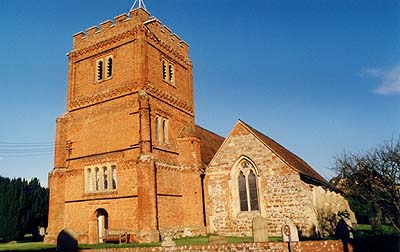 |
 |
|||
|
|
In Saxon times, Shinfield was served by the Minster at Sonning. The first church in the parish was built by order of the lord of the manor, William FitzOsbern, the Earl of Hereford, in 1069. He features in the modern window at the end of the south aisle. FitzOsbern gave the church, and its sub-chapel at Swallowfield, to his monastic foundation in Lire (France) but foreign abbeys were not popular in England and it was confiscated during Edward I's reign. In 1320, it was given to the Dean & Chapter of Hereford and its profits used for the rebuilding of their Cathedral. Seven years later, they passed the church to the Bishop of Worcester in thanks for his help in obtaining the canonization of their former master, St. Thomas Cantilupe. The present building at Shinfield was largely put up in the decorated style of the 14th century, and still retains the original nave roof with a fine array of huge timbers in an uncommon form. It does, however, incorporate parts of an older building, as particularly evidenced by its good Norman doorway (late 12th century). The South or Martyn Chapel was added in the last years of the 16th century by the lord of the manor, Edward Martyn, as recorded on a tablet outside: 'EM 1596'. His renaissance style wall monument has been moved to the south aisle. Though his wife and daughter are prominently displayed, unfortunately his own kneeling figure has disappeared. The contemporary ceiling of the chapel is wood panelled with moulded ribs and decorative bosses. Some of the fittings in the south aisle are also of this period, including the grand Elizabethan altar table and the Jacobean chest. The superb monument to Henry Beke (died 1580) of Hartley Court, which was so admired by John Betjeman, is one of the finest in the county. he has a second memorial at the west end of the nave, alongside an unusual monument to a young boy called Huick Steward, whose family heraldry records their supposed descent from the Royal Stuarts. He was the brother of Lady Forster of Aldermaston House and of Simeon Steward, the poet. The hatchments are Victorian, one to a vicar and two to the Hulme family of Shinfield Grove, relatives of the Breedons of Bere Court whose hatchments are so prolific in the parish church at Pangbourne. During the Civil War, a group of retreating Royalist troops took refuge in Shinfield Church and took up a strategic position at the top of the tower. However, the Parliamentarians soon arrived and, surrounding the building, blasted the men out of the sky! The tower was thus left a ruin and, it was not rebuilt until four years after the Restoration of the Monarchy, in 1664. It was then decided to rebuild in Berkshire brick, the clay for which was dug from the fields opposite. It has very lively friezes or string-courses marking the division of each storey. It may be surmised that much of the tower masonry fell onto the south aisle as the roof there was restored around the same time; and buttresses were added to the Martyn Chapel. The Vicar of Shinfield had been ousted in 1646 for "lewd behaviour"! He, however, appointed a local cordwainer, and anabaptist preacher, in his place who served the local community throughout the Commonwealth period. However, at the Restoration, the vicar was ordered to return. Both he and his replacement protested and the preacher, being popular with the locals, brought sixty "stout fellows" from Reading to support his claim. The final outcome of the dispute is, however, unknown. This is not the official Shinfield Church website. Please do NOT mail me about use of the church. Visit the C of E's Church Near You website instead.
|
|||
| © Nash Ford Publishing 2004. All Rights Reserved. | ||||



 Shinfield
Shinfield